Blue Yet Microphne Liove Stream Keyboard to Loud
Intro
Every streamer knows that stream quality is a crucial factor of a successful live stream. However, stream quality is about more than just a high-quality image and fancy overlays. When it comes to professional streams, audio plays a huge role too. Many viewers prefer listening to streams rather than actually watching them.
How do you get good audio quality? With an awesome microphone! There are tons of audio companies producing great mics, but all of them have pros and cons. This guide covers the technical features of microphones and reviews 11 of the best ones for live streaming.
🤔 How to choose a streaming microphone
Here are four characteristics to consider when choosing a microphone for live streaming.
1. Frequency response
Frequency response is the range of voice frequencies your microphone can pick up. It's measured in hertz (Hz) and kilohertz (kHz), from the lowest frequencies to the highest. Typically, the golden standard for frequency response is from 20 Hz to 20,000 Hz. Anything lower or higher than these spectrum extremes is pretty much useless, as the human voice simply cannot produce such frequencies.
2. Polar pattern
A polar pattern, also known as directional property, is the inherent sensitivity to the direction of audio waves. Simply put, a polar pattern is the ability of a microphone to pick up your voice from different angles. The three polar patterns you need to know are cardioid, omnidirectional and bidirectional.
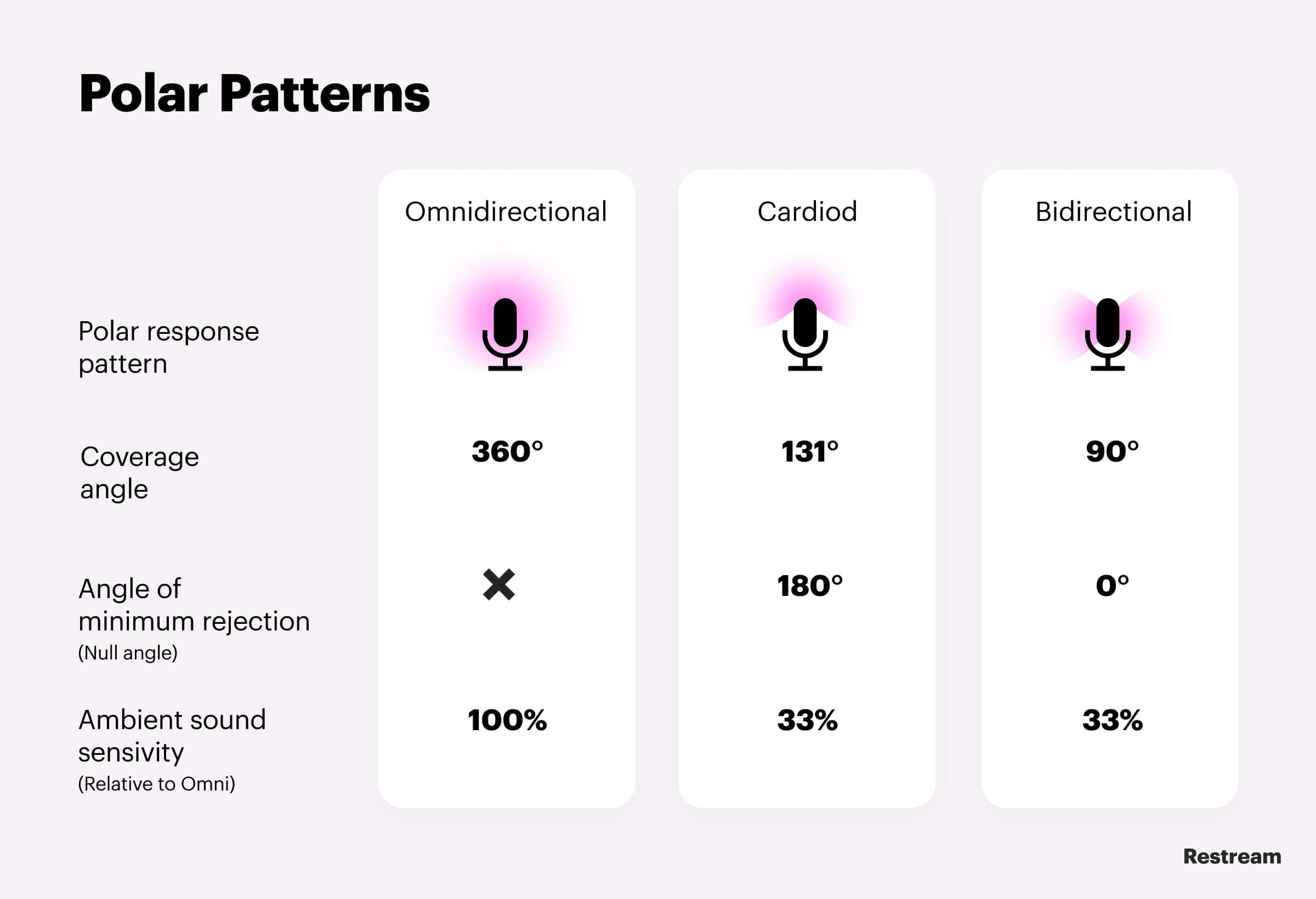
- Cardioid polar pattern. A classic cardioid microphone picks up the sound from the front. Cardioid microphones isolate unwanted ambient sound, as well as any other unwanted sounds, from the back of the microphone. They are the most common choice for live streaming, as they block sounds such as a loud fan or the clatter of your mechanical keyboard.
Cardioid subtypes, known as super-cardioid and hyper-cardioid, have narrower sound sensibility angles and a greater ability to reject ambient sound. However, it is harder to place and aim these microphones accurately.
- Omnidirectional polar pattern. Omnidirectional microphones are equally sensitive to sound from every direction. This means they evenly pick up sound from 360 degrees. The bright side is that you don't need to aim an omnidirectional microphone at the source of the sound. However, it will pick up all undesired background noises along with your speech.
- Bidirectional polar pattern. Bidirectional microphones have a so-called figure eight type of sound capture. This means a bidirectional microphone will pick up any sound from two sides: the front of the microphone and the back. A bidirectional microphone is especially useful for live streaming interviews, as it can pick up both your speech and your guest's.
3. Connection method
The two most common mic connection methods for streaming are XLR and USB, and they have some substantial differences. First, you cannot connect an XLR mic directly to your PC. You need to buy a mixer or audio interface to plug in an XLR microphone. With this additional investment, you'll get more control over the sound — thus better overall sound quality.
Second, XLR cables are more robust and durable than USB connections, so they last longer. This long life is reflected in the price, however, making XLR microphones the most expensive on the market.
Last, don't forget about TS/TRS/TRRS-based microphones. This connection method is used to plug your microphone into mobile phones, tablets and laptops. The sound quality of these microphones is usually worse than that of XLR mics. TS/TRS/TRRS microphones are, therefore, best suited for mobile streamers.
4. Pop filter
A pop filter, also called a pop screen or pop shield, is a noise protection filter for microphones. It's most often used in recording studios to eliminate any popping sounds that occur when the airflow bumps into the microphone. Applying a pop filter to your microphone results in the clearer sound of your voice on the viewer's end.

Easy live streaming for everyone
Run professional live streams from your browser.
Get Started
🔥 Best microphones for streaming
Let's look at some examples of microphones that are well suited for live streaming. These options accommodate different streaming needs and budgets.
1. Shure SM7B
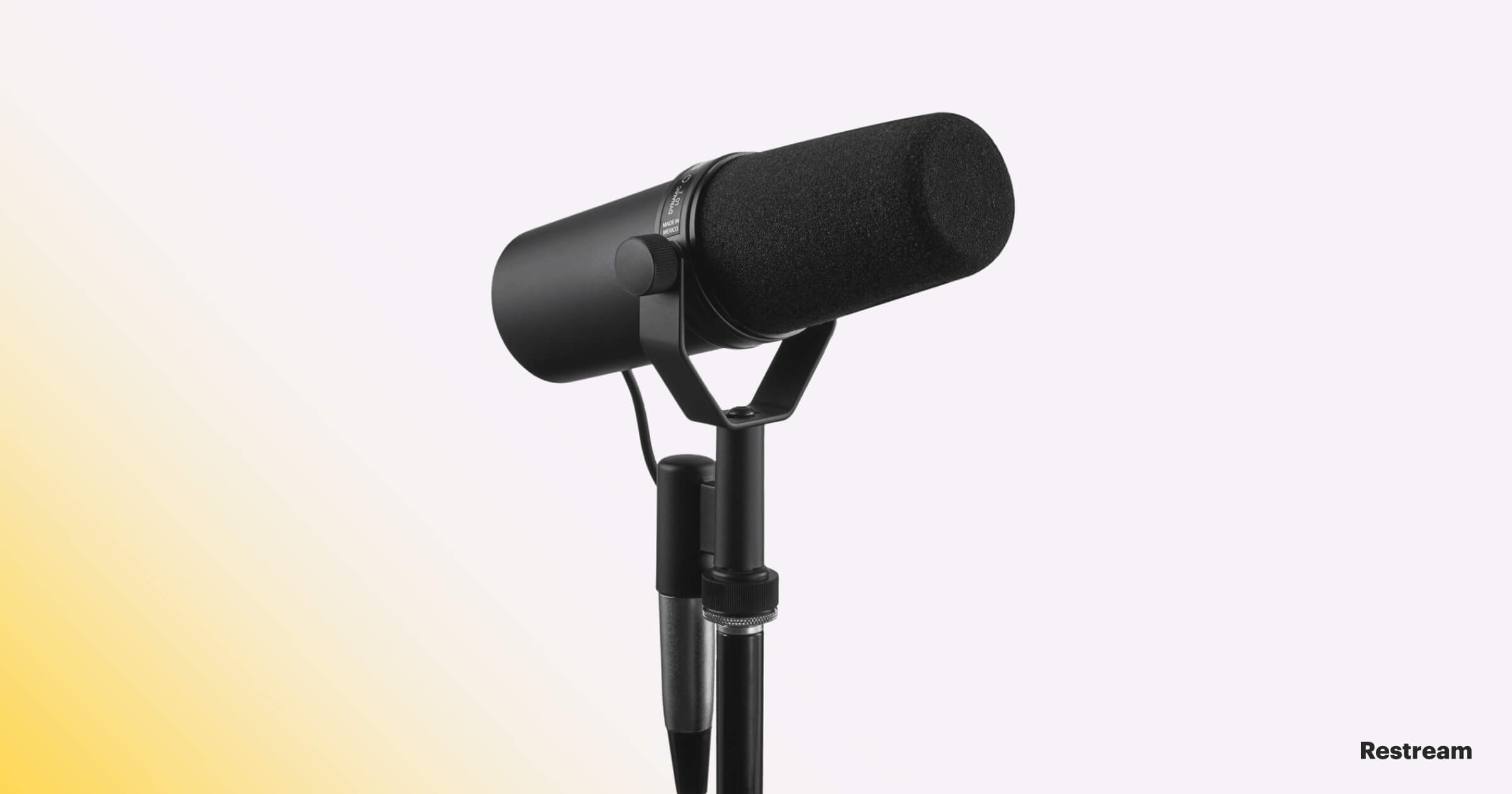
Shure is a legendary audio company that specializes in high-quality microphones. The Shure SM7B is a professional microphone for vocalists, which makes it an excellent choice for ASMR streams. Don't just take our word for it — lots of top streamers are using it, including Shroud, Tfue and Sodapoppin.
Specs:
- Frequency response: 50 Hz - 20,000 Hz
- Polar pattern: Cardioid
- Connection method: XLR (no cable included)
- Pop filter: Included
➕ Pros:
- High rejection of background noise
- Great durability
- High-quality sound
➖ Cons:
- High price
- Requires an XLR cable, audio interface (or mixer) and a stand
2. Shure MV7
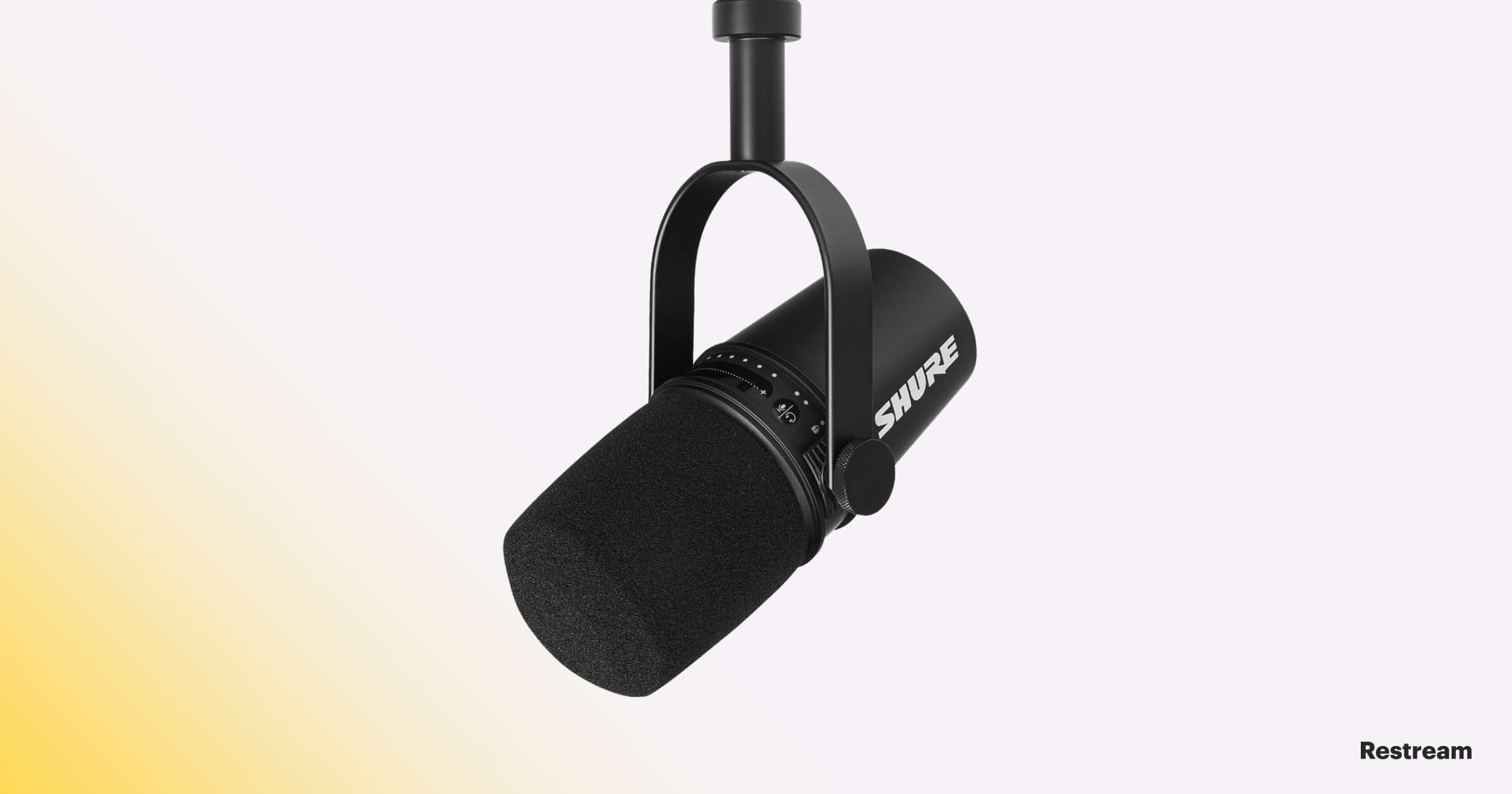
The MV7 is Shure's first USB/XLR hybrid, and it delivers on both quality and flexibility. It does an excellent job of isolating noise, making it great for at-home use. You can get professional-grade audio and record it on the go thanks to the Type-B Micro inputs that come with the MV7. If you're a streamer or podcaster looking for a major audio upgrade, this microphone delivers. You don't get that kind of quality without paying more for it, and the MV7 can be pricey. The MV7 retails for less than Shure's most popular broadcasting mic, the SM7B, though.
Specs:
- Frequency response: 20Hz – 20,000 Hz
- Polar pattern: Cardioid
- Connection method: USB or XLR
- Pop filter: Not included
➕ Pros:
- Dual connection (USB or XLR)
- Robust ShurePlus Motiv software included
- High-quality vocal audio
➖ Cons:
- Mic stand not included
3. Audio-Technica AT2020+
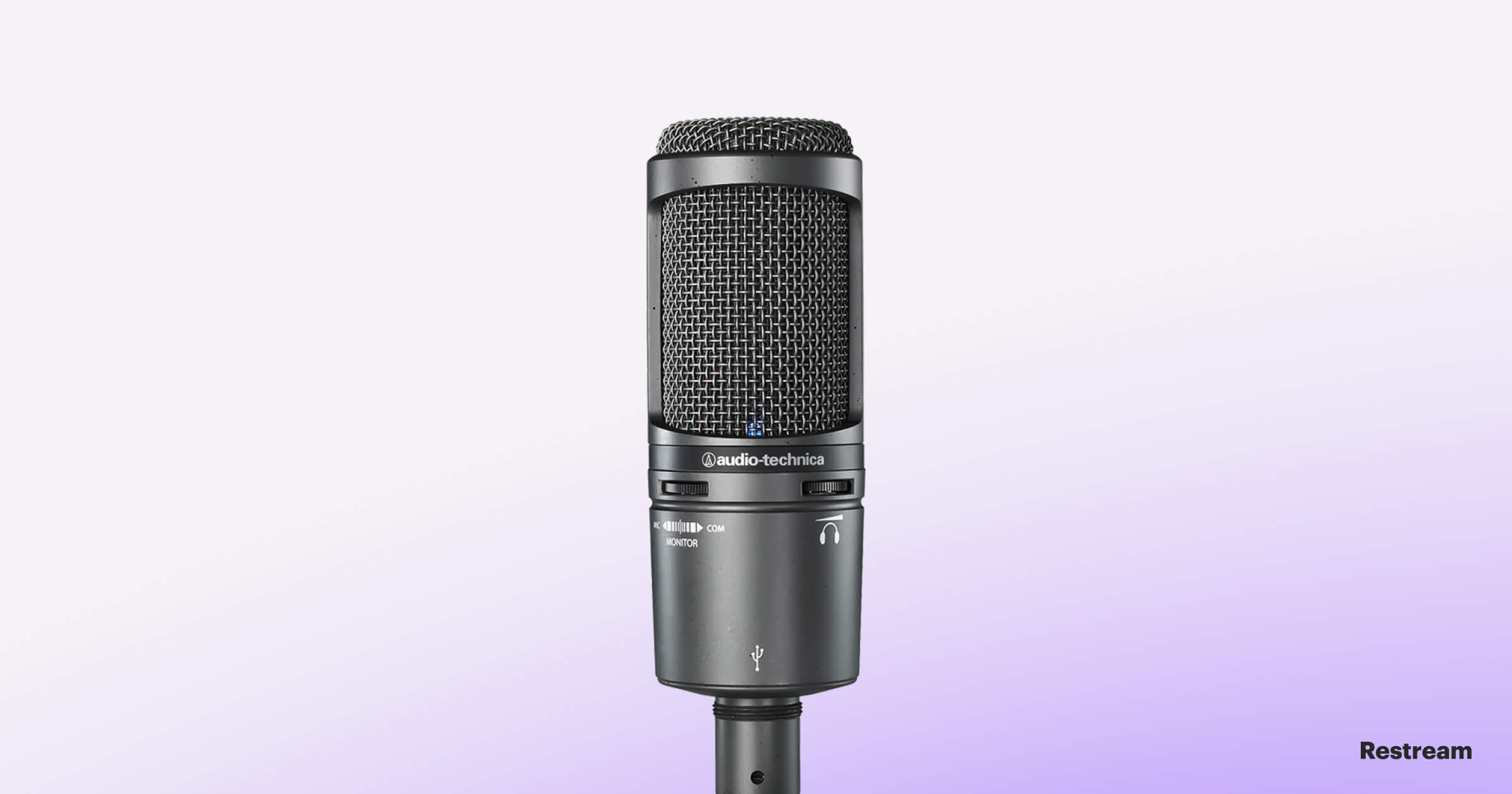
The Audio-Technica AT2020 and above are probably the most popular series of professional microphones for streaming on the list. The Audio-Technica AT2020 and higher models combine amazing sound quality and a reasonable price, which makes them some of the best microphones for streaming in 2022. Top streamers like Ninja, Pokimane, Yassuo and Dr. DisRespect use these microphones.
Specs:
- Frequency response: 20 Hz - 20,000 Hz
- Polar pattern: Cardioid
- Connection method: XLR (no cable included) or USB
- Pop filter: Included
➕ Pros:
- Reasonable price
- Great durability
- USB option
➖ Cons:
- No XLR cable included
- USB version requires a pre-amp (an amplifier that converts the weak signal from the microphone into a stronger one to prevent distortion and background noise)
4. Audio-Technica AT2005USB
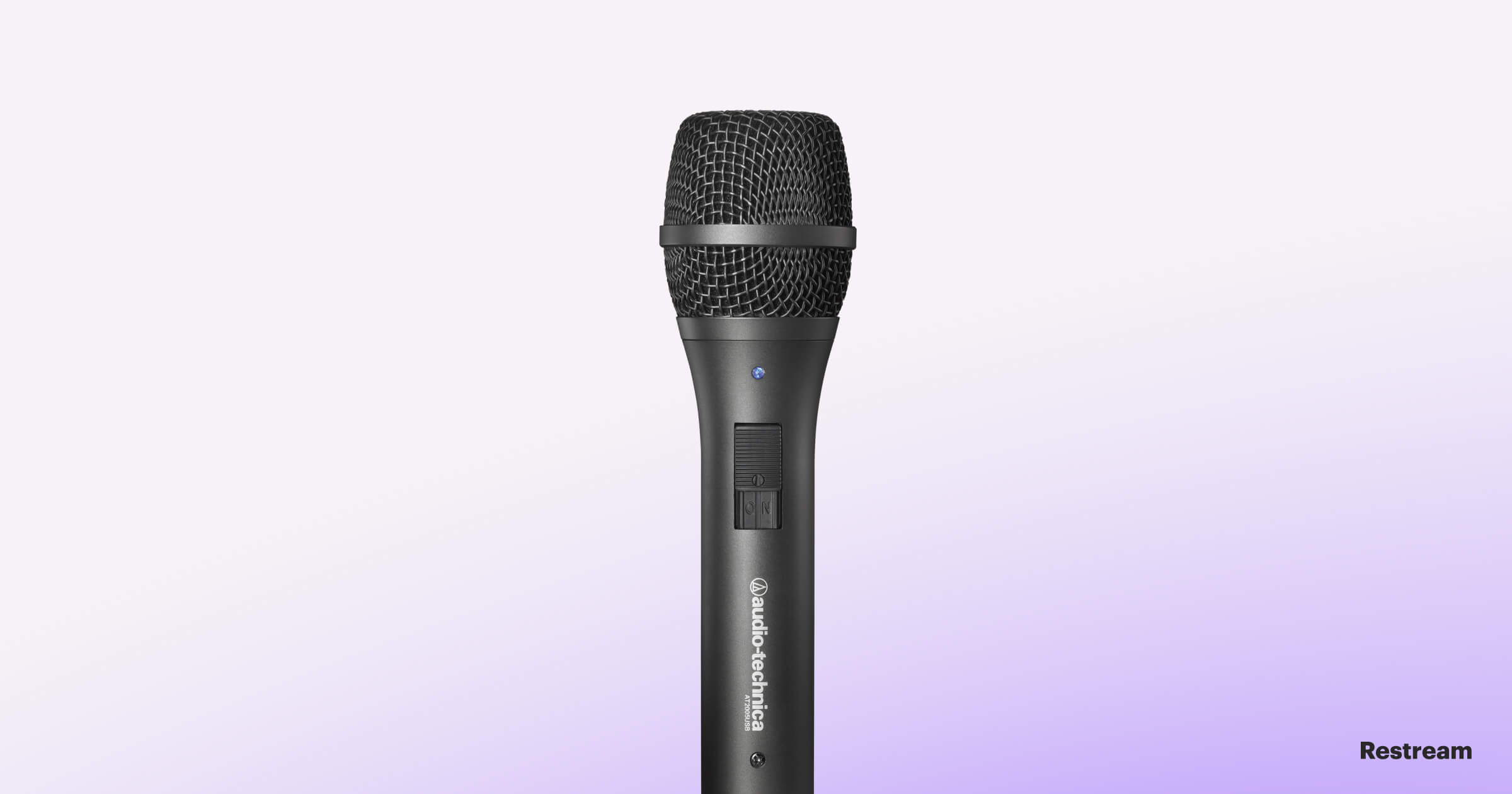
The Audio-Technica AT2005USB microphone's biggest selling point is its versatility. With both USB and XLR connection capabilities, it can accommodate stage performances and live events as well as video and live stream production. More and more podcasters, streamers and at-home content creators are choosing this mic because it easily blocks out background noise and comes with a desktop stand. It does require cleaning up the gain to sound good, though — which you need an audio interface or good post-production software for.
Specs:
- Frequency response: 50 Hz - 15,000 Hz
- Polar pattern: Cardioid
- Connection method: USB or XLR
- Pop filter: Not included
➕ Pros:
- Dual connection (USB or XLR)
- Durable, hard metal casing
- Comes with tripod desk stand and mic clamp for conventional stand
- Good for streaming and live events
➖ Cons:
- Not many features compared to similar mics
- Quiet
5. Blue Yeti USB
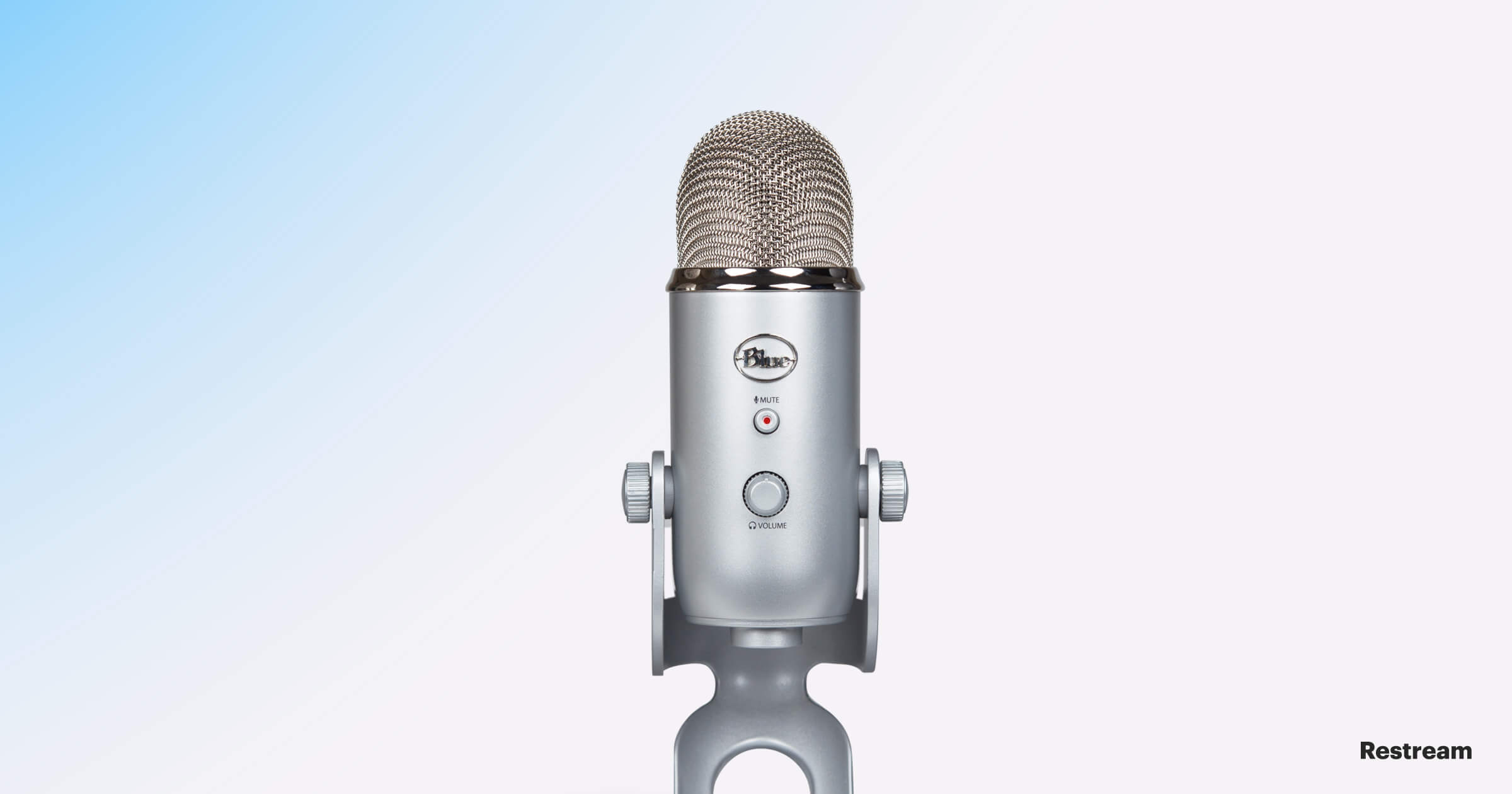
Another great option for live streaming, Blue Yeti mics offer superior sound quality compared to other USB microphones. Streamers like DrLupo and Myth are using the Blue Yeti USB. The mic is easy to use since it doesn't require a stand and other cables. Moreover, you can switch between all polar patterns, from cardioid to omnidirectional.
Specs:
- Frequency response: 20 Hz - 20,000 Hz
- Polar pattern: Multipattern (cardioid, bidirectional and omnidirectional on your choice)
- Connection method: USB
- Pop filter: Included
➕ Pros:
- Relatively cheap
- Easy to connect
- Polar pattern switcher
➖ Cons:
- Has to be kept strictly upright
- USB sound quality
6. Electro Voice RE20
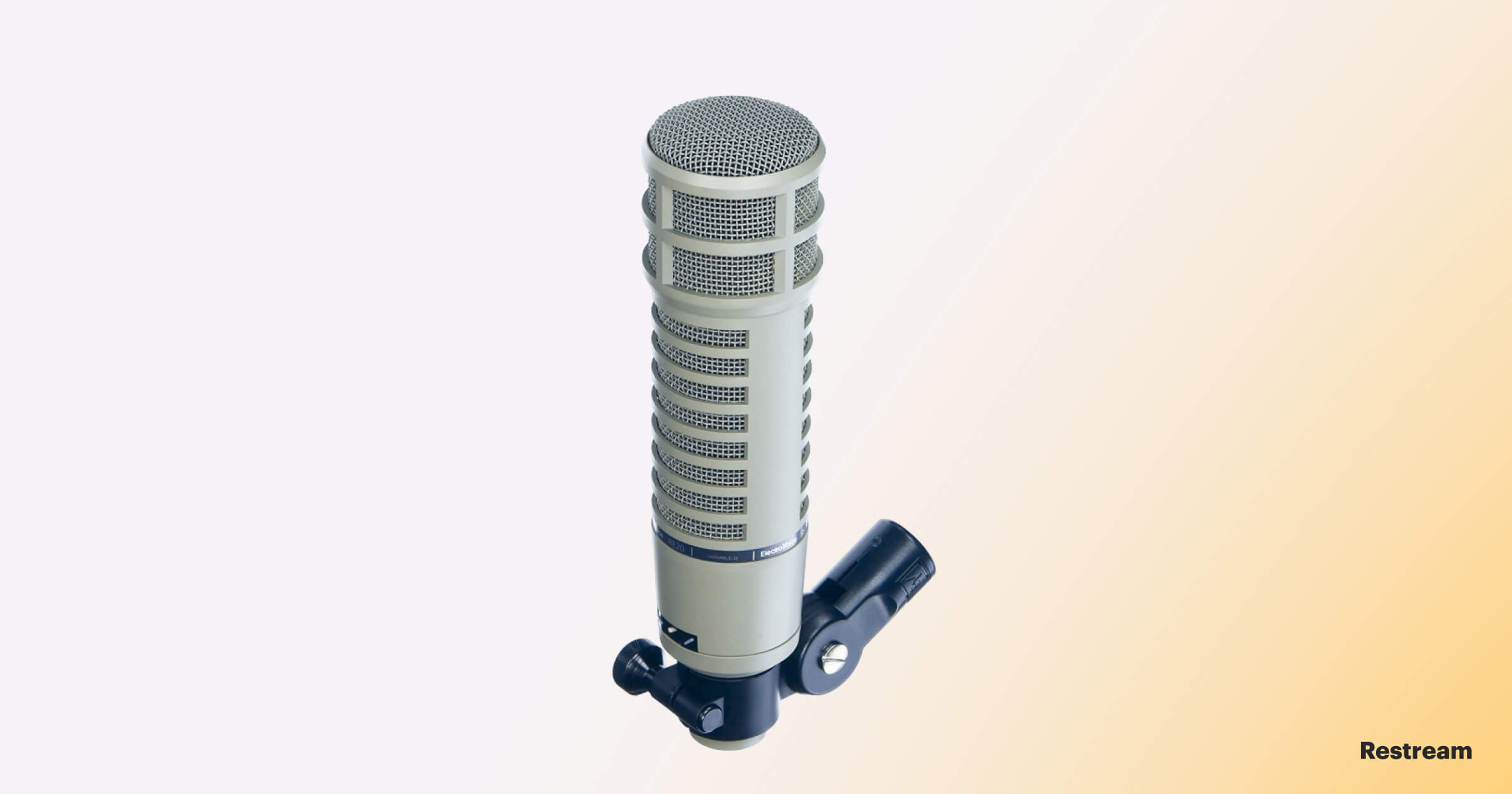
The incredibly clear Electro Voice RE20 is a great option for professional recording, but it might not be so great for live streaming because of its price. The microphone has a built-in pop filter, element shock mount and windscreen to eliminate any unwanted noise. Streamers like Imaqtpie and Comikaze are using the Electro Voice RE20.
Specs:
- Frequency response: 45 Hz - 18,000 Hz
- Polar pattern: Cardioid
- Connection method: XLR (no cable included)
- Pop filter: Built-in
➕ Pros:
- Built-in pop shield, shock mount and windscreen
- Clear, high-quality sound
- High durability
➖ Cons:
- Very high price
- Requires an audio interface and XLR cable
7. HyperX QuadCast
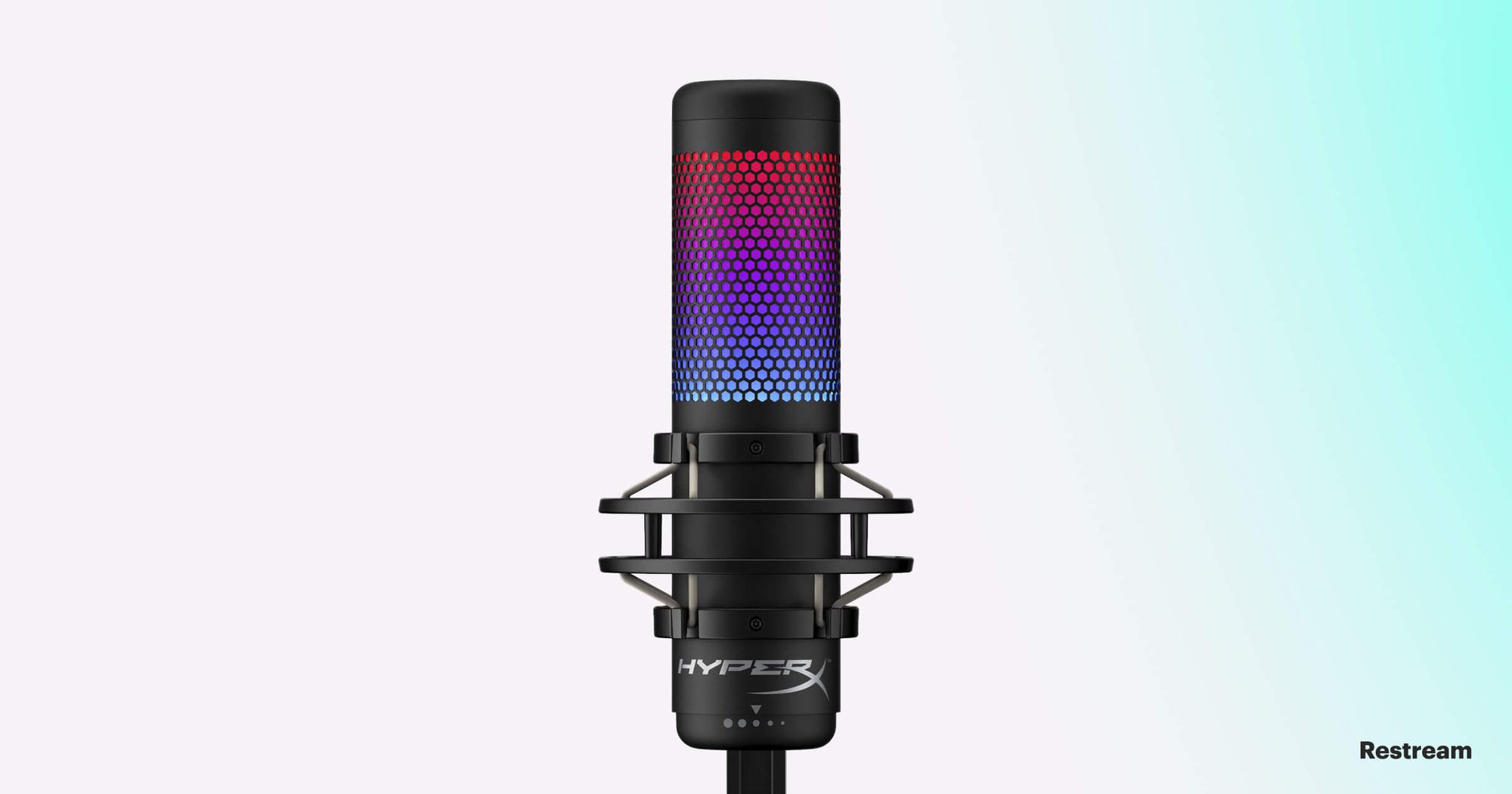
If you're a fan of fancy gamer gear, the HyperX QuadCast might be your choice. It has a USB connection type, as well as a built-in pop filter. This microphone has cool red LED lighting, and a desk stand provides a shock mount. Unfortunately, you can't turn the lighting off, which is surely a minus.
Specs:
- Frequency response: 20 Hz - 20,000 Hz
- Polar pattern: Multipattern (cardioid, bidirectional and omnidirectional on your choice)
- Connection method: USB
- Pop filter: Built-in
➕ Pros:
- Built-in pop shield
- Clear sound
- LED lighting
- Low price
➖ Cons:
- Boosts sibilant sounds (f, s, sh, etc.) a bit
- Can't turn off the LED lighting
8. Elgato Wave:3
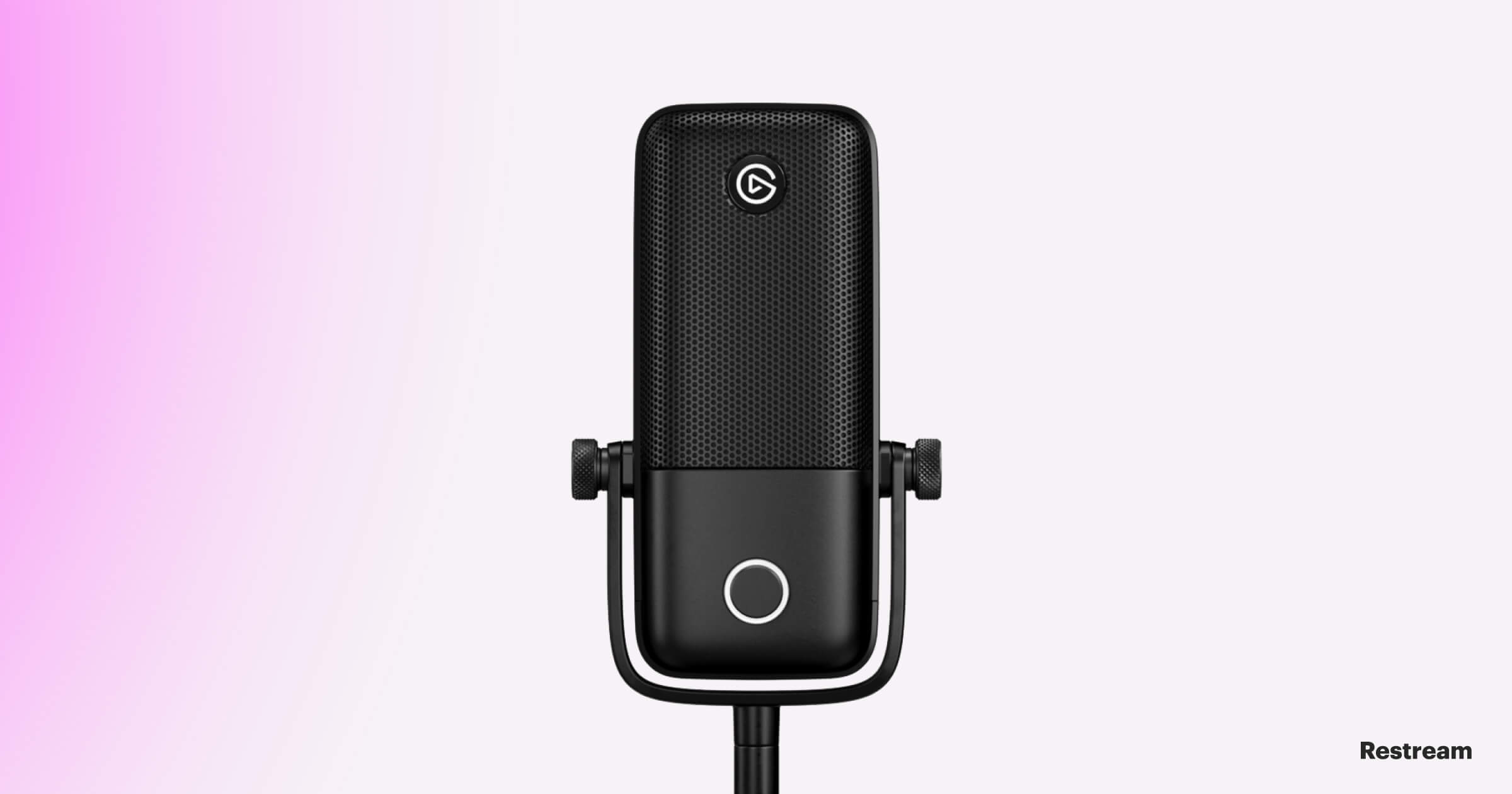
Elgato is a big name in streaming gear, so you can expect a microphone like the Elgato Wave:3 to be designed for live streaming. The biggest appeal of this mic is the Wave Link software that lets you mix up to eight channels of audio within your stream. The Wave:3 isn't as versatile as other mics, though, with only one polar pattern.
Specs:
- Frequency response: 70 Hz - 20,000 Hz
- Polar pattern: Cardioid
- Connection method: USB
- Pop filter: Included
➕ Pros:
- Works well with other Elgato streaming gear
- Clear audio
- Digital mixing software
➖ Cons:
- Single polar pattern
- Not very versatile
🤓
Bonus tip: On some occasions, a bulky microphone might not be a good option. Any form of live content where you're moving around a lot — webinars, stage performances, fitness classes — requires a more elegant solution: a lavalier microphone, also known as a lapel microphone, clip-on microphone or lav mic. You can learn more in our article about lavalier microphones.
9. Razer Seiren Elite

Razer's Seiren Elite is a top-quality microphone in a more affordable price range. It's easy to use with only a few knobs to control mic gain, headphone volume and mute. The Seiren Elite also has a built-in compressor to even out the volume — you'll see the LED base ring light up when it's activated. The bit rate is the minimum by today's standards, however, at 16 with a 48,000 Hz signal. It also doesn't quite achieve the clarity needed for a classic radio sound compared to other mics in the same price range.
Specs:
- Frequency response: 20 Hz - 20,000 Hz
- Polar pattern: Cardioid
- Connection method: Micro-USB
- Pop filter: Included
➕ Pros:
- Easy-to-use controls
- Smooth output that prevents background noise from being picked up
- Built-in compressor
➖ Cons:
- Razer Synapse app doesn't support further tuning of output
- Minimum frequency signal by today's standards
10. AKG Lyra
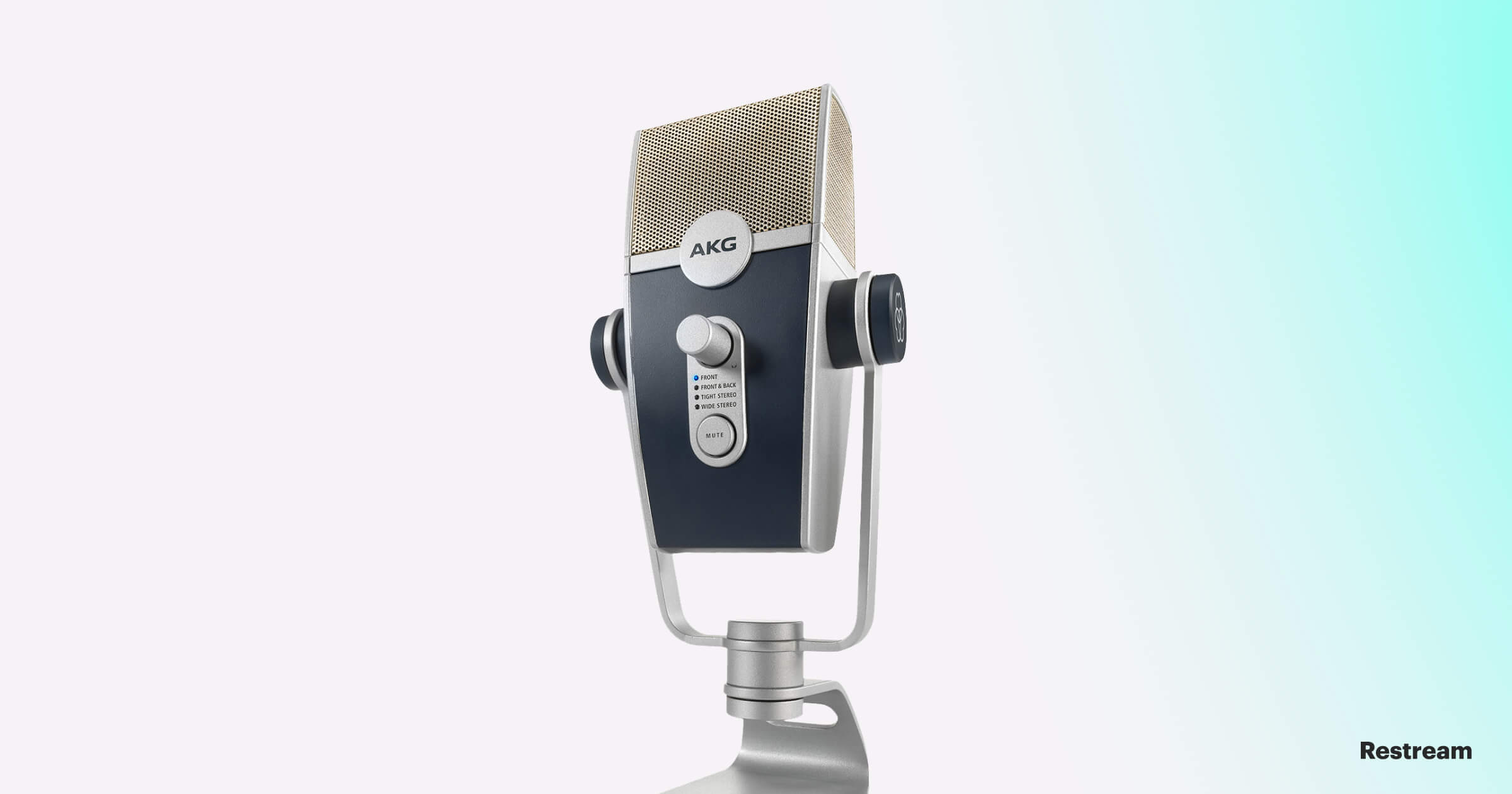
The AKG Lyra has a four-capsule array that lets you pick up sound differently depending on your needs. You can choose single-direction recording for capturing just your voice or do front and back recording for interviews. The Lyra is also easy to plug in and start using, with no extra audio interface or equipment needed. It comes with a stand for your desk, and its sleek design adds a professional look to your live streaming studio. This mic can be so sensitive, however, that learning to adjust volume levels appropriately will take some time for beginners.
Specs:
- Frequency response: 20 Hz - 20,000 Hz
- Polar pattern: Four capture modes
- Connection method: USB
- Pop filter: Not included
➕ Pros:
- Good sound quality for streamers, podcasters and video content creators
- Ultra HD audio
- Four pick-up patterns
➖ Cons:
- Buttons are in an awkward spot
11. Rode PodMic
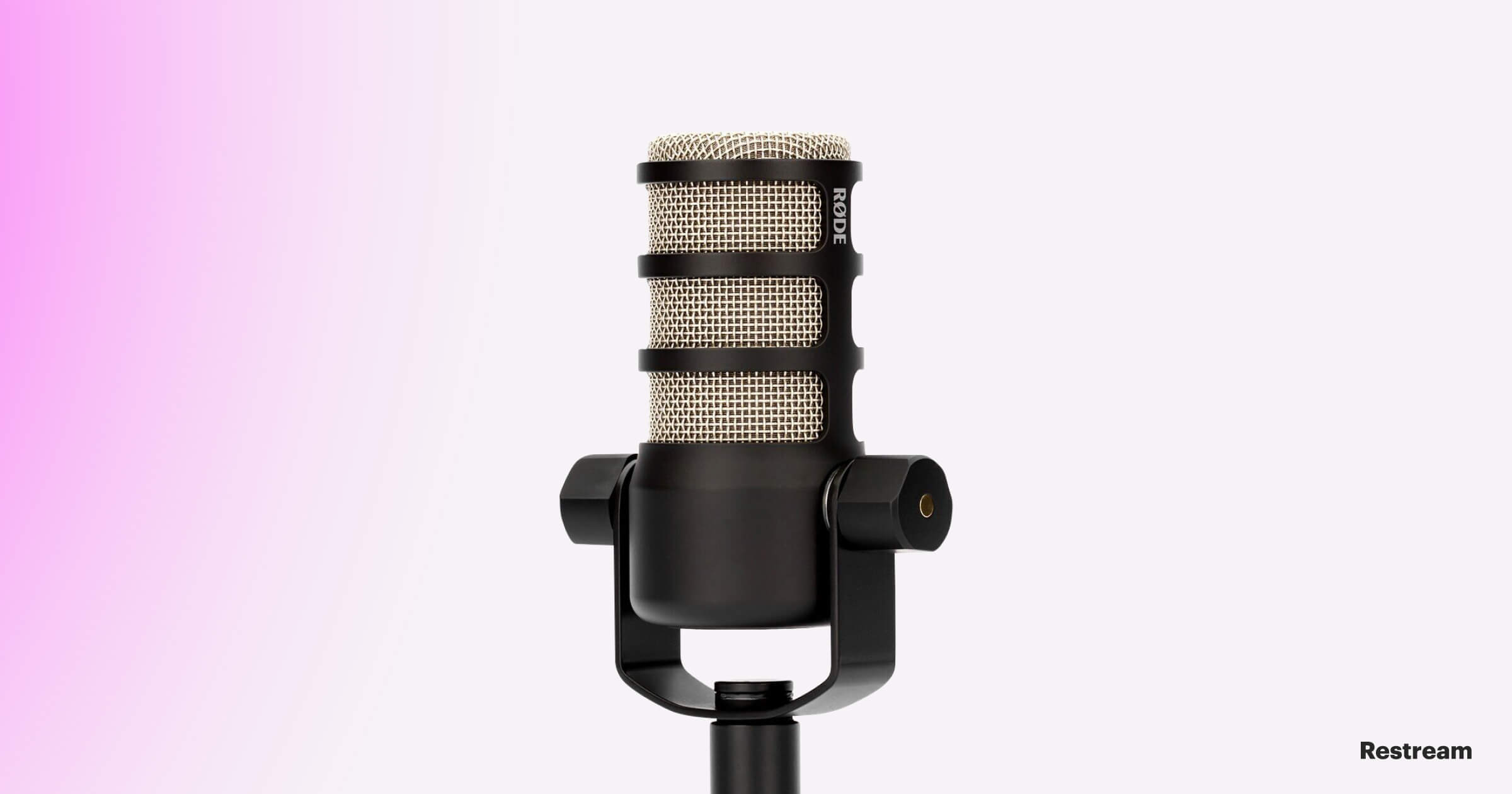
The Rode PodMic is a dynamic microphone designed for broadcasting from your desk. It excels at quieting all background noise, so you can tap on your keyboard or click your mouse as much as you want; your listeners or viewers will barely be able to hear it. Despite the quality, which comes at a budget-friendly price, it's not quite as ready to use as other similar microphones. It's an XLR mic, so you need an audio interface to connect it to your computer. Since it has to be close to your mouth to pick up your voice, you also need a mic arm.
Specs:
- Frequency response: 20 Hz - 20,000 Hz
- Polar pattern: Cardioid
- Connection method: XLR
- Pop filter: Included
➕ Pros:
- Solidly built mic that holds a rigid position
- Good for streamers or content creators who don't have a good recording environment
- Affordable in comparison to quality
➖ Cons:
- No USB connection
- Might need additional gain to sound good
👀 What other gear do you need to stream professionally?
A microphone is only one piece of the gear that makes up a basic streaming setup. You also need:
- Camera: People have to be able to see you!
- Solid internet connection: Uploading live video requires speedy internet.
- Headphones: Wearing headphones eliminates echoes when you stream.
- Lavalier mic: You can get up and move around while streaming if you have a clip-on mic.
- Computer: You need a device to stream from, whether it's a computer or mobile device.
- Lighting: One cheap, well-placed light can make a huge difference for your video quality.
- Streaming software: If you stream from a computer, you need software that pushes your video live onto platforms like YouTube, Facebook and Twitch.
To really take your streams to the next level, you might consider the following additional gear:
- Capture card: Capture footage from a device other than your computer and stream it with a capture card.
- DSLR camera: Get higher-quality video with a DSLR camera instead of a webcam.
- Audio mixer: Control the quality of your stream's sound more precisely.
- Green screen: Add virtual backgrounds to your stream with chroma key.
- Video switcher: Perfect a multi-camera setup for a stream or live event with a video switcher.
You need to pick the right gear and the right streaming platform if you want a professional-looking live stream. With Restream Studio, you can create engaging and high-quality streams in a matter of a few clicks. Our browser-based live streaming studio has tons of features to help you out, including:
- Adding your own logos and overlays
- Inviting guests onto your stream
- Playing copyright-free background music
- Sharing your screen or displaying split-screen streams
- Recording your live shows to repurpose later
- Streaming in Full HD
- Displaying comments from the live chat on your stream
- Adding captions and lower-third graphics
- Gathering insights on audience engagement
- Broadcasting to multiple platforms simultaneously
Check out our full guide to Restream Studio to see how you can level up your live streams.
Let's recap
When it comes to the technical characteristics of microphones for streaming, you should look at frequency response, polar patterns and connection methods. Typically, the best streaming microphones have a 20 Hz to 20,000 Hz frequency response, a cardioid polar pattern, and an XLR type of connection. XLR requires an additional audio interface or mixer to connect the microphone, though.
Depending on your streaming needs and available budget, we listed 11 great microphones for you to choose from. The best microphones for streaming in 2022 include:
- Shure SM7B — classic, yet expensive
- Shure MV7 — on-the-go streaming
- Audio-Technica AT2020+ series — overall well-balanced
- Audio-Technica AT2005USB — perfect for stage events and live streams
- Blue Yeti USB — versatile and easy to use
- Electro Voice RE20 — elite and high-priced
- HyperX QuadCast — trendy and cheap
- Elgato Wave:3 — built for streamers
- Razer Seiren Elite — high-quality at a decent price
- AKG Lyra — professional look
- Rode PodMic — sturdy and built for streamers
Source: https://restream.io/blog/best-microphones-for-streaming/
0 Response to "Blue Yet Microphne Liove Stream Keyboard to Loud"
Post a Comment